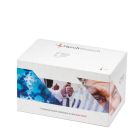MBL, Human, ELISA kit – 2 x 96 det. - HK323-02
Quantity
2 x 96 det.
Catalog #
HK323-02
1.223,00 €
Mannose Binding Lectin (MBL), an integral component of innate immunity, belongs to the collectin protein family. It uniquely combines a collagen-like domain with a carbohydrate recognition domain (CRD). This structure enables MBL to recognize specific carbohydrates, such as mannose and N-acetylglucosamine, present on pathogens. MBL forms oligomers, each comprising three identical 32 kDa polypeptides, functioning as a pattern recognition receptor. Upon encountering infectious agents, MBL activates the lectin-complement pathway, independent of the classical and alternative pathways.
In this pathway, the MBL-MASP complex crucially cleaves C4, C2, and C3. Unlike the classical and alternative pathways, it operates without the need for antibodies and C1q. Primarily synthesized in the liver, MBL is also present in the serum of various vertebrate species. In human plasma, MBL levels range significantly, from 10 to 5,000 ng/ml. Notably, up to 12% of healthy Caucasians exhibit MBL concentrations below 100 ng/ml, often associated with inherited opsonization defects.
MBL levels rise in response to infectious diseases, making its measurement essential in various medical scenarios. These include recurrent infections in children, immunodeficiencies, cardiovascular diseases, cystic fibrosis, and autoimmune conditions. The human MBL assay, designed for precision, remains unaffected by antibodies against mannan. Utilizing a specialized binding buffer, it inhibits classical pathway interference while preserving MBL's functionality. This approach underscores MBL's critical role in immune system diagnostics and research.
In this pathway, the MBL-MASP complex crucially cleaves C4, C2, and C3. Unlike the classical and alternative pathways, it operates without the need for antibodies and C1q. Primarily synthesized in the liver, MBL is also present in the serum of various vertebrate species. In human plasma, MBL levels range significantly, from 10 to 5,000 ng/ml. Notably, up to 12% of healthy Caucasians exhibit MBL concentrations below 100 ng/ml, often associated with inherited opsonization defects.
MBL levels rise in response to infectious diseases, making its measurement essential in various medical scenarios. These include recurrent infections in children, immunodeficiencies, cardiovascular diseases, cystic fibrosis, and autoimmune conditions. The human MBL assay, designed for precision, remains unaffected by antibodies against mannan. Utilizing a specialized binding buffer, it inhibits classical pathway interference while preserving MBL's functionality. This approach underscores MBL's critical role in immune system diagnostics and research.
| Datasheet URL | https://www.hycultbiotech.com/wp-content/uploads/2022/06/HK323-1123.pdf |
|---|---|
| Quantity | 2x96det. |
| Quantity | 2 x 96 det. |
| Standard range | 0.41-100 ng/ml |
| Detection level | 0.41 ng/ml |
| Working volume | 100 µl/well |
| Species | human |
| Cross reactivity | Cynomolgus monkey - Yes, Pig - No |
| Alias | Mannose- or mannan-binding protein (MBP) |
| Application | The human MBL (Lectin assay) ELISA kit is to be used for the in vitro quantitative determination of human MBL in serum, plasma and cell culture supernatant samples. |
| Principle | The human MBL ELISA is a ready-to-use solid-phase enzyme-linked immunosorbent assay based on the sandwich principle with a working time of 4 hours. The efficient format of a plate with twelve disposable 8-well strips allows free choice of batch size for the assay. After activation, samples and standards are captured by solid bound mannan. Biotinylated tracer antibody will bind to captured MBL. Streptavidin-peroxidase conjugate will bind to the biotinylated tracer antibody. Streptavidin-peroxidase conjugate will react with the substrate, tetramethylbenzidine (TMB). The enzyme reaction is stopped by the addition of oxalic acid. The absorbance at 450 nm is measured with a spectrophotometer. A standard curve is obtained by plotting the absorbance (linear) versus the corresponding concentrations of the MBL standards (log). The MBL concentration of samples, which are run concurrently with the standards, can be determined from the standard curve. |
| Storage and stability | Product should be stored at 4 °C. Under recommended storage conditions, product is stable for at least six months. |
| Precautions | For research use only. Not for use in or on humans or animals or for diagnostics. It is the responsibility of the user to comply with all local/state and Federal rules in the use of this product. Hycult Biotech is not responsible for any patent infringements that might result with the use of or derivation of this product. |
| References | 1. Kirkpatrick, B et al; Serum mannose-binding lectin deficiency is associated with
cryptosporidiosis in young Haitian children. Clin Infect Dis 2006, 43: 289 2. Druszczynska, M et al; Tuberculosis bacilli still posing a threat. Polymorphism of genes regulating anti-mycobacterial properties of macrophages. Pol J Microbiol 2006, 55: 7 3. Wang, X et al; Mannose-binding lectin gene polymorphisms and the development of coal workers pneumoconiosis in Japan. Am J Ind Med 2008, 51: 548 4. Ribeiro, L et al; Serum mannose-binding lectin levels are linked with respiratory syncytial virus (RSV) disease. J clin immunol 2008, 28: 166 5. Koutsounaki, E et al; Mannose-binding lectin MBL2 gene polymorphisms and the outcome of hepatitis C virus-infected patients. J Clin Immunol 2008, 28: 495 6. Satomura, A et al; Functional Mannose-Binding Lectin Levels in Patients with End-Stage Renal Disease on Maintenance Hemodialysis. J Innate Immun 2012 7. Tao, R et al; Genetic polymorphisms and serum levels of mannose-binding lectin in Chinese pediatric patients with common infectious diseases. Int J Infect Dis 2012 |
| Disease | Infectious diseases |
| Application assays: | The human MBL (Lectin assay) ELISA kit is to be used for the in vitro quantitative determination of human MBL in serum, plasma and cell culture supernatant samples. |
|---|---|
| Principle: | The human MBL ELISA is a ready-to-use solid-phase enzyme-linked immunosorbent assay based on the sandwich principle with a working time of 4 hours. The efficient format of a plate with twelve disposable 8-well strips allows free choice of batch size for the assay. After activation, samples and standards are captured by solid bound mannan. Biotinylated tracer antibody will bind to captured MBL. Streptavidin-peroxidase conjugate will bind to the biotinylated tracer antibody. Streptavidin-peroxidase conjugate will react with the substrate, tetramethylbenzidine (TMB). The enzyme reaction is stopped by the addition of oxalic acid. The absorbance at 450 nm is measured with a spectrophotometer. A standard curve is obtained by plotting the absorbance (linear) versus the corresponding concentrations of the MBL standards (log). The MBL concentration of samples, which are run concurrently with the standards, can be determined from the standard curve. |




